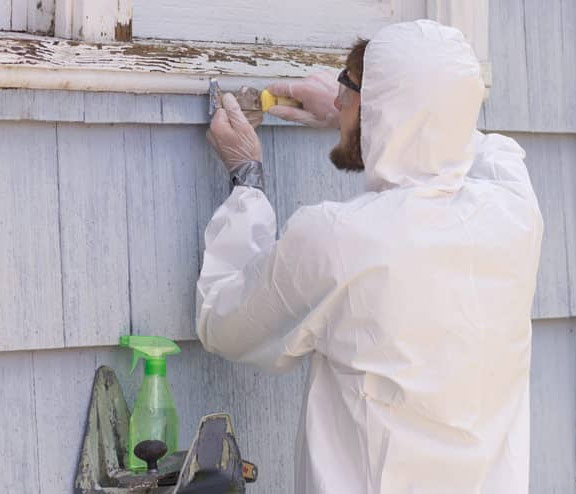Comprehensive Guide on Effective Lead Violation Elimination Techniques
In the world of ecological safety and security, dealing with lead violations demands a thorough and organized approach. This extensive overview begins by highlighting the important initial steps of recognizing lead dangers via innovative analysis and testing methods. Techniques such as XRF analysis and dirt wipe sampling are indispensable in identifying contamination sources. Furthermore, the overview specifies on the relevance of sticking to rigorous safety protocols throughout the removal process, consisting of the usage of proper PPE and separating impacted areas (Lead Paint Removal Company). The succeeding areas guarantee to go over post-removal verification and preventive approaches, making certain lasting safety and security and conformity. Discover the elaborate information that make these strategies not just effective yet essential.
Identifying Lead Threats
Recognizing lead threats is a crucial very first step in reducing the dangers associated with lead exposure. Lead, a hazardous steel, can be present in numerous environmental tools, consisting of paint, soil, water, and dust.
The preliminary stage in determining lead threats entails understanding typical lead sources within the built setting. Structures built before 1978 are particularly vulnerable as a result of the common usage of lead-based paint during that duration. Furthermore, soil contamination can take place from degrading outside paint, industrial emissions, or historic usage of leaded gasoline.
An additional significant resource is lead piping and plumbing fixtures, which can leach lead right into alcohol consumption water. Durable goods such as toys, ceramics, and imported products might additionally contain damaging lead degrees. Especially, occupational settings and pastimes involving lead can track pollutants into homes.
Evaluation and Screening
When addressing lead threats, effective analysis and screening are critical. This essential step makes sure the recognition and quantification of lead presence, thus guiding subsequent remediation efforts. First analysis typically entails a visual examination to recognize possible lead resources, such as degrading paint or polluted dirt. This is complemented by even more extensive screening methods to ascertain the level of contamination.

Dust wipe sampling is another critical technique, particularly in property settings. By accumulating samples from floorings, windowsills, and various other surfaces, this approach provides understandings into potential exposure risks. Dirt testing around structure boundaries is important to discover lead contamination that could posture dangers, especially to children.
Safe Removal Procedures
Upon finishing complete evaluation and testing, carrying out risk-free removal treatments is the following essential stage in resolving lead hazards. This procedure ensures that lead-contaminated products are efficiently and securely eradicated, reducing risk to both employees and citizens. The very first action includes separating the affected location using plastic sheet and appropriate securing strategies to stop the spread of lead dust.
Employees have to don appropriate personal protective equipment (PPE), including respirators, gloves, and disposable coveralls, to mitigate exposure. Employing specialized devices and wet approaches, such as wet fining sand or making use of HEPA-filtered vacuum cleaners, reduces the dispersion of lead resource fragments. It is vital to prevent completely dry fining sand or unpleasant blasting, as these methods can produce harmful lead dust.
Garbage disposal is another important element; all polluted products should be securely landed and identified according to EPA and regional policies. Additionally, detailed cleansing of the workspace with HEPA vacuum cleaners and wet wiping guarantees the elimination of residual lead particles.
Post-Removal Verification

Verification of effective lead elimination, known as post-removal confirmation, is essential to ensure the safety and security and habitability of the remediated area. This inspection makes certain that all well-known sources of lead have actually been dealt with and that no visible indications of contamination stay.
Following the visual evaluation, environmental sampling is performed. This includes collecting dust, dirt, and often water samples from the remediated area. Accredited laboratories assess these samples to gauge lead levels, ensuring they fall below the security limits Read Full Report developed by regulative bodies such as the Environmental Protection Agency (EPA)
Furthermore, air top quality testing may be done to spot air-borne lead particles, particularly in cases where substantial lead-based paint elimination or restoration has actually happened. The outcomes of these tests give measurable data confirming that the lead degrees are within check my blog permissible limits.
Ultimately, post-removal verification works as an important checkpoint, validating the performance of the lead abatement initiatives and securing the health of residents and visitors.
Safety Nets and Upkeep

An essential precautionary measure includes the usage of lead-safe accredited service providers for any type of renovation, repair service, or painting activities. These experts are educated in methods that lessen lead dirt and particles. Additionally, preserving colored surface areas to stay clear of damaging or peeling off is crucial, as weakening paint can release lead bits into the atmosphere.
Educational initiatives targeting property proprietors and tenants relating to the dangers of lead and the importance of reporting any potential hazards can further boost preventative initiatives. Routine cleansing making use of HEPA vacuums and damp mopping techniques can dramatically minimize lead dirt build-up.
Final Thought
In recap, effective lead violation elimination demands a careful strategy incorporating detailed assessment, exact testing, and strict elimination treatments. Recurring assessments and upkeep are crucial to mitigate future lead threats, therefore guarding public wellness and making sure sustained conformity with governing needs.